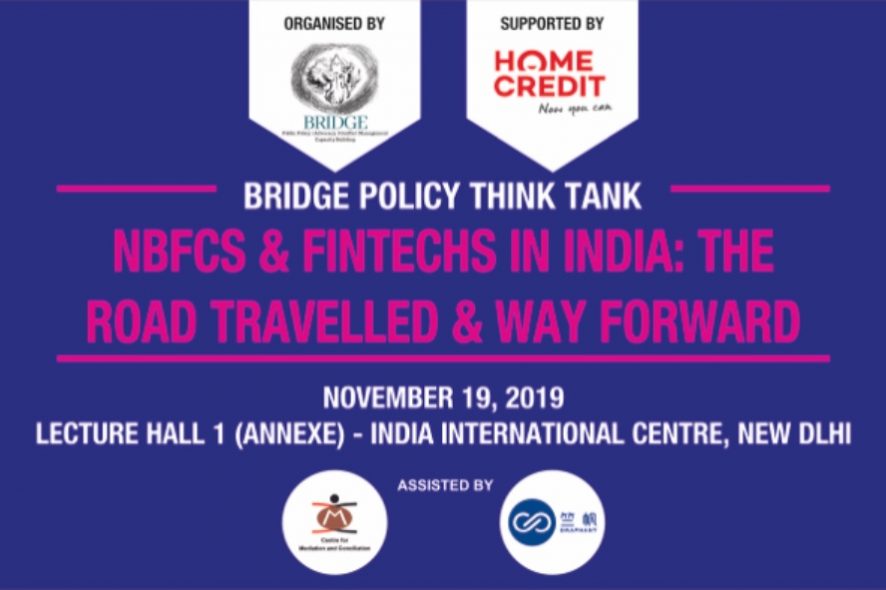(Anuroop Omkar, Director, Bridge Policy Think Tank and Aditi Jha, Consultant, Bridge Policy Think Tank)
The idea for this write-up finds its inception from the discussion at the Panel Discussion at the Symposium on ‘NBFCs & FinTechs in India: The Road Travelled: Way Forward’ held in New Delhi on 19 November 2019 organised by Bridge Policy Think Tank. This two-part article on the Central KYC system in India aims to discuss the roadblocks faced by the regime and suggest measures to pave them.
Mr. Marko Carevic, Chief Marketing Officer at Home Credit, India argued that simply because a new credit customer does not have a credit rating, the same does not necessarily translate to credit lending with high risk. He made a suggestion that the data to ensure the quality of a borrower can be gathered from various other sources, including via transactions made through e-wallets, etc. Dr. Aruna Sharma, Member of the Committee on Deepening of Digital Payments in India of Reserve Bank of India elucidated that to increase access to credit, it is important to consolidate data related to financial activities for banking and non-banking purposes on a single forum. Hence it is important to maintain an efficient central-KYC system in the country.
But as has been seen noticed in the central KYC regime has not been able to reach its potential owing to various issues in the system. In 2015, the Central Government setup the Central Registry of Securitisation Asset Reconstruction and Security Interest of India (CERSAI). All ‘reporting entities’ under the Prevention of Money Act, 2002 (PMLA, 2002) were required to share their client’s information with CERSAI. These reporting entities include, banking company, financial institution, intermediary or a person carrying on a designated business or profession.[1] The Central KYC Registry application can be accessed by institutions under the PMLA 2002 or any Regulator (RBI, SEBI, IRDA and PFRDA).
Since then 100 million KYC records have already been uploaded into CERSAI.[2]However, in order for it to achieve its full potential, the following issues must be paid attention to :
- Presently the regulated entities pay charges of INR 0.80, 1.10 and 1.15, to upload, download or edit the record for each customer respectively.[3] Although the reporting entities are mandated by law[4] to submit the details of their customers, it is important to realise that the costs incurred by reporting entities is very high. This fee may be considered to be affordable for entities with high capital, however smaller entities, including but not limited to smaller NBFCs may not be able to afford these services
- In addition to this, the dream of appropriate authorities having access to all the relevant information about the financial trail of an individual is far from being achieved unless all the sector-specific repositories are assimilated or coordinated. For instance, the Securities and Exchange Board of India (SEBI) and the Insurance Regulatory and Development Authority (IRDAI) maintain their own repositories. The CERSAI’s CKYC is not integrated with these repositories, which requires the customers to provide KYC documents again at each of these forums.
As a part of the regime setup by SEBI, under its KYC (Know Your Client) Registration Agency Regulations, 2011, the KRAs shall be responsible for storing, safeguarding and retrieving the KYC documents and submit to the Board or any other statutory authority as and when required. There are 5 KYC (Know Your Client) Registration Agency registered and 5 such Insurance repositories registered with SEBI[5]and IRDAI[6] respectively.
- In addition to this, if the RBI allows Banks and other financial institutions to furnish their KYC requirements on the basis of the process carried out by another financial institution, the cost of KYC for the industry as a whole would reduce. Since the KYC formalities carried out by an NBFC can make the customer better equipped to be to receive a loan from the bank and thereby increase access to credit, it shall foster financial inclusion as well. To better explain the idea, if Mr. X takes a loan from NBFC ‘A’, and later opens an account or intends to take credit from Bank ‘B’, this Bank should consider the KYC procedure done by NBFC ‘A’ by quoting his Unique Identification Number as listed by CERSAI.
The second part of this article, shall discuss the key features of the international best practices in the field of central KYC system, the potential of India to adopt the same and how India could shape its future policies to ensure that the Central KYC regime is strengthened enough to achieve its’ objective.
[1] Section 2(w), Prevention of Money Laundering Act, 2002.
[2]Shri Shaktikanta Das, Governor, Reserve Bank of India – Keynote Address on ‘Opportunities and Challenges of FinTech’ at the NITI Aayog’s FinTech Conclave, 25 March 2019.
[3]Frequently Asked Question, CERSAI, https://testbed.ckycindia.in/ckyc/?r=faq
[4] Central Registry of Securitisation Asset Reconstruction and Security Interest of India (CERSAI), Central KYC Registry Operating Guidelines 2016
[5] SEBI, KYC (Know Your Client) Registration Agency, as on April 17, 2017, https://www.sebi.gov.in/sebiweb/other/OtherAction.do?doRecognisedFpi=yes&intmId=8
[6]IRDAI, List of Insurance Repositories updated as on June, 2019, https://www.irdai.gov.in/ADMINCMS/cms/NormalData_Layout.aspx?page=PageNo2054&mid=9.7.1






